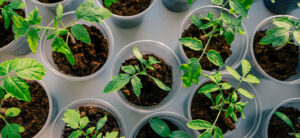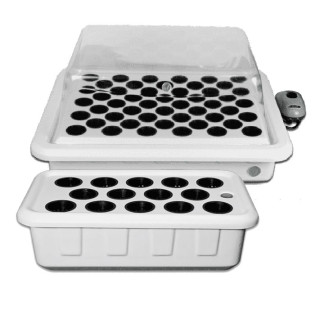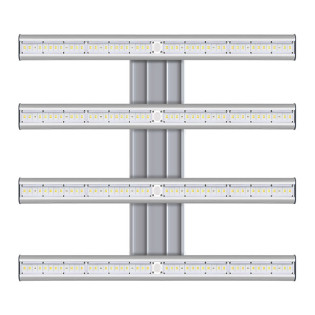
If you are growing a plant with superior genetics and you realize part way through the grow that you want to grow it again, you need to know how to clone a plant.
One of the two main methods of propagation, cloning plants allows you to skip some of the difficult phases of germinating seeds, and decreases your time till harvest.
It produces fast results from a reliable genetic source. It’s one of the easiest ways to guarantee consistent quality. Plus, it’s cheaper than buying seeds, as you can constantly pull new, young plants off one mother plant!
There are a few different ways to go about cloning, and for this guide, we will focus on cloning with traditional pots and soil along with using a cloning system. These two methods vary in terms of ease and price, so we'll help you choose the right one.
First, let's talk about how to select a mother plant, and how to actually cut your clones off her. Because you will essentially be replicating her genetic data, this is the most important step of the whole process.
Can Any Plant Be Cloned?
Just about any plant that produces roots can be cloned. When you think of cloning plants, you may only think of one or two plants in particular.
However, you can really attempt to clone any vegetable or flowering plant. In fact, some plants actually clone themselves without any human help!
We have a guide on how to clone a tomato plant for our veggie gardeners, as this is a plant that is commonly cloned. So if you're feeling up to the task, read on to learn how to clone any plant!
How To Select A Mother Plant For Clones
Before you ask, "how do you clone a plant?" you need to ask "how do you select the right mother plant to take clones from? The process of cloning requires a big, bushy plant to take cuttings from.
Choosing the best mother plant in your garden is essential for a high success rate. Think about it like this:
You are taking a plants entire genetic makeup, and duplicating it. So if you choose a mother plant that is showing slow growth, sickly foliage, and is prone to pests and diseases, you are setting yourself up for failure.
Find the strongest, healthiest female plant in your grow room. If you are growing a strain you have harvested before, you may have noticed you love the taste, potency, and effects of this particular plant. This would make it a perfect candidate for cloning.
You can evaluate the root zone, stems, and foliage for signs of whether the mother is healthy or not. Once you have decided on a mother plant, you need to watch for signs she is ready to have cuttings stripped from her.
How can you tell when a mother plant is ready to be cloned?
You want to take cuttings from the mother when she is well into vegetative growth, around 4-8 weeks to be exact.
Watch for shoots of growth with at least 6 nodes on them. This is a good indication the mother plant is ready to be stripped.
Also watch for branches on the mother plant to start alternating as they grow.
Once you notice these signs and start preparing, withhold feeding for a few days. This is known as flushing your plant. This flush will squeeze excess nitrogen from the plant, which is very important.
Without any nitrogen in our cuttings, they can focus all their energy on rooting, instead of vegging. We'll discuss additional nutrition requirements for your fresh cuttings later on.
Once you have chosen your mother plant and given her a quick flush, you are ready to take your cuttings. Don't do anything else to stress her out during the coming days - this includes manipulating the lighting schedule, training your plant, etc.
Pay attention closely to the next steps, as they are crucial to success. We are going to now teach you how to actually clone a plant.
How To Clone Plants The Correct Way!
I know you are excited to learn how to clone plants. You are itching with anticipation to duplicate your favorite plant into small, baby plants, but let's pump the brakes.
Preparation is incredibly important, and you need to get a few things in order. We'll start by helping you dial in your propagation environment so you can provide ideal conditions for these fresh cuttings.
Then, we will explain how you clone a plant without a cloning system. This is going to be tougher and we don't recommend you try and get it done this way, but for those on a budget, it may be the only option. Then, we will describe the steps you take if you do have one.
Dialing In Your Cloning Environment
Plants are fickle in general, with very specific ideal grow room environment conditions. But, clones are even more specific with what they need to start taking root and growing from cuttings into plants of their own.
The ideal cloning environment is warmer and more humid than your grow room would typically be during flower, and even during veg. You should shoot for temperatures between 70-80 degrees Fahrenheit, and humidity between 70%-80%.
Creating this lower vapor pressure defecit in the grow room will encourage plants to uptake moisture through their foliage, which is essential while these cuttings don't yet have a root system.
Manipulating the environment is as simple as using a humidity dome and seedling heat mat. On a larger scale (for bigger, commercial cloning rooms) you may need to invest in a grow room heater and a grow room humidifier.
From a lighting standpoint, you can't go wrong with fluorescent T5 grow lights. This will give your plants the energy they need to start producing their own root mass and grow into plants of their own.
You should check out our review of the best T5 grow lights of the year for a recommendation. Now, let's move onto the rest of the supplies you'll need to get this done right.
Prepare your plant cloning supplies
Cloning plants can be as simple or complex as you want - the results will vary accordingly. If you want, you can simply take clones and stick them in soil.
However, you're not going to get the same rooting rate (essentially your success rate) as you would using an aeroponic cloning machine and cloning gel.
The most important things you will need, regardless of how you clone a plant, are:
- A clean pair of scissors
- A cloning gel or root enhancer
- Small pots for initial rooting or a cloning tray and dome
- Starter cubes or other grow media
If you want to make this process easier, just use a complete plant cloning kit. These include everything you need, including a small grow tent, to cultivate healthy clones with a high success rate.
We'll talk more about these in a moment, because they truly are a godsend to growers. If you are a serious grower, these are a no-brainer investment.
But, grab whichever supplies you decide you need. Then, read on to learn how to clone a plant at the most basic level.
Cut your clones at a 45 degree angle
The most complicated part of learning how to clone a plant is understanding where to actually make the cut and remove a shoot of growth.
Cut a branch from the lower part of the plant if possible. Any branch can technically turn into a clone, but lower branches tend to have stronger concentrations of nutrients due to their proximity to the grow media. You can cut top branches too, if necessary.
The cut must be at a 45 degree angle, and with a clean pair of scissors or knife. This will prevent introducing disease or contaminants into the plant.
Afterwards, branches should be immediately dipped into water and coated with cloning gel or root enhancer.

Why use a cloning gel or root enhancer?
Clones are very fragile, and any boost you can give them helps ensure a healthy, mature plant.
Cloning gels provide a way to seal the area where your clone was cut from the mother plant, and trigger the clones to start a healthy root system in an area of the plant that was previously not a root zone.
Many provide hormones to stimulate growth as well as provide antifungal and antibacterial elements to protect new roots. These will rapidly speed up the rate at which your clones take root.
They are inexpensive, so investing in rooting hormones is another no-brainer. If you can get to harvest even a week sooner, it's worth it! Read our guide on how to use rooting hormones for more information on this.
Once adequately coated in rooting gel, the cutting should be placed into your starter plug or the grow media. We recommend rooting plugs for their ease of use.
Pruning your clones
Once you transplant your clones into their initial growing medium, you should remove any large fan leaves. This will prevent the clone from trying to undergo photosynthesis when it should be focusing on root development.
Don't go too crazy, however, as the clone does need some foliage.
How long do clones take to root?
When learning that you can actually do this, your first question is probably how to clone a plant. It's very likely that your second question is how long do clones take to root?
After 7-14 days, new root development should start to emerge from the stem. This root growth is very fragile and should not be disturbed.
Once roots are about 2" inches long or protruding through the rockwool, it is time to transplant the new plants into their final vegetative media.
It can be tough to be patient during this two-week period, but you should try and keep your hands off your plants as much as possible.
Just let nature run its course, and check for signs your clones are ready for transplant. Now, let's explain why you might want to consider a cloning system.
How To Clone A Plant With A Cloning Machine
Compared to cloning with root-plugs or pellets, cloning machines provide a higher success rate and avoid many of the pitfalls of the cloning procedure such as over or under-watering.
Seedlings and cuttings are especially prone to failure due to their underdeveloped root structures. Cloning systems focus on root care and nurture healthy, dense roots.
To clone with a cloning machine, you will follow the exact same steps as traditional cloning.
Once you have your cutting dipped in rooting gel, you will put it in a neoprene insert, and place it in the system.
Cloning systems provide ideal conditions for rooting

Young plants require elevated levels of humidity, often around 70%.
Many cloning systems also include a heating pad to elevate air and grow media temperature.
Warmer air can hold more water vapor, and elevated grow media temperature nurtures moisture uptake and root development.
Air movement is also important to cut down on mildew or rot under such humid conditions.
Young plants do not need as much light as mature plants so it is important to size your light and proximity to the plant canopy correctly for maximum benefit.
New plants need careful monitoring and cloning machines offer a higher rate of success as well as an added level of automation.
Many cloning systems utilize hydroponic or aeroponic growing methods to grow more efficiently.
Learn Which Cloning Machine Is Best For You!
There are so many cloners out there and they all appear to do the same thing, right?
Wrong. Some of the plant cloning machines you'll find online are cheap plastic, with problematic emitters that will clog, break, etc.
Luckily, we put together a guide of the best cloning machines to help you shop with confidence. If you are a DIY type, and looking to save some money, try building your own plant cloner by reading our step-by-step guide.
How To Feed Your Clones Nutrients
A common question from those new to cloning is how you feed your clones?
Generally, during the first few weeks, plain water is fine. Plants have low nutrient requirements at this point.
If you'd like, you can use a low strength formulation, and just dip your clones in it (provided they are still in a starter plug or rockwool cube).
If you are using a cloning system, you can try a cloning or rooting solution.
Using a cloning and rooting solution with your cloning system
Rooting solutions work to strengthen and enhance the roots of your plants. They reduce mineral build-up as well in your system, and reduce the likelihood for harmful root toxins and plant pathogens.
The Clonex Clone Solution is a very popular product for use in cloning systems.
This will act as the "nutrients" you feed your plants in the first few weeks of growth, before moving to a full strength nutrient package for vegging.
We also highly recommend UC Roots from Cultured Solutions. It can also be used to sterilize grow media such as clay pebbles or grow stones before or after a grow cycle.
UC Roots will work with any brand of nutrient products and makes an excellent addition to any grow cycle.
Final Thoughts On How To Clone A Plant
Now that you know how to clone a plant, you can gather your supplies and get started right. You have the knowledge, now you just need the right tools.
Otherwise, check out the cloning essentials we have here at Hydrobuilder, and get your propagation setup started on the right foot!
If you're a new grower, consider reading our complete guide to indoor growing too. It will help you understand the next steps after your clones have taken root.






































